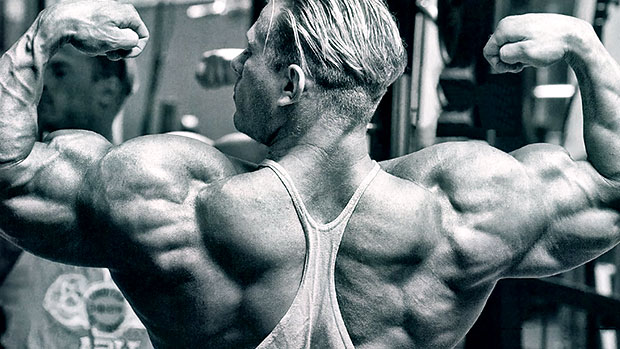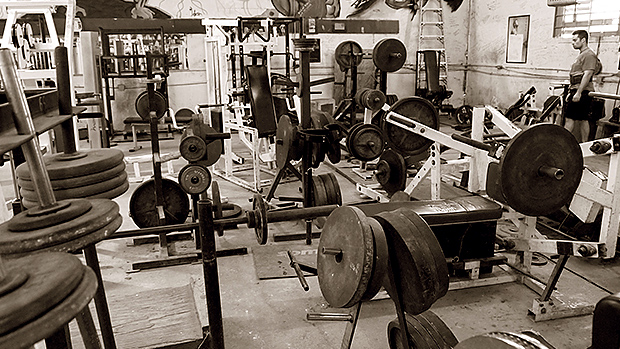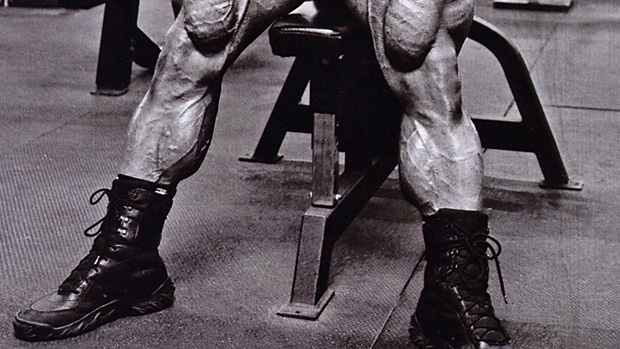Elements and Arms
Tim Patterson recently asked me to write an article for the advanced trainee who needs to overcome a plateau in arm development. Makes sense, as I've yet to see a bodybuilder satisfied with the size of his arms.
Furthermore, since my Five Elements article drew so much interest, Tim asked me how to arrange this workout to fit each lifter's element. As a reminder, I believe each of these ancient classifications predicts how different strength athletes respond to different types of training. It also predicts quite accurately their personalities and even their weaknesses. So, you'll be able to customize this arm program to fit your element.
The following twice-per-day routine is nasty; it creates a lot of soreness, but it works. You should preferably leave 4 to 6 hours between workouts. Make sure to consume post-workout drinks after both sessions. After I present the program, I'll show you how to adapt it to your element.
Let's get started!
Morning Workout
A1 – Low Incline Offset Dumbbell Curl


5 x 4-6 reps on a 40X0 tempo*, rest 10 seconds, move to A2
* This means you'd lower the weight in four seconds and immediately change direction and lift explosively for the concentric portion.
Comments: Use a 30-degree incline bench and grab the dumbbells with an offset grip – the index finger sides should be glued to the inside plate. Start with a semi-supinated grip (neutral).
Supinate (as you come up) and do only one-fourth of the range of motion very rapidly. Re-extend the arms back to the starting position quickly, and (using the stretch reflex) supinate curl the dumbbells up fast, keeping the elbows back for at least the first 90 degrees of range of motion (almost as you would if doing a barbell drag curl). Lower the dumbbells under control for a count of 4 seconds.
A2 – Close-Grip Barbell Scott Curl
5 x 4-6 reps on a 40X0 tempo, rest 2 minutes, move on to A3
Comments: The Scott bench was designed to enforce strict curling technique, particularly on the eccentric (lowering) portion of the movement. All too often though, I see trainees using form reminiscent of a penguin having an epileptic seizure. One Mr. Olympia finalist tore his biceps because he failed to use proper technique on this bench.
I prefer the seated version of the Scott bench because it minimizes cheating. The bench shouldn't be too high; otherwise, it puts stress on the lower back. Set the height of the seat so that the tops of your thighs are parallel to the floor. It's best if the seat is angled downward toward the curling post. This puts the lower back in a more ergonomic position for curling.
Sit on the Scott bench. Grasp the barbell using a supinated (palms-up) grip with your little fingers four to six inches apart. Your arms should be outstretched so that your triceps are in contact with the padded surface. Initiate the movement by bending your elbows.
Curl the barbell to the point where your elbow flexors are just about to lose tension, then reverse the movement. Make sure that your elbow flexors are fully stretched in the bottom position. Keep your wrists cocked back throughout the full range of motion.
A3 – Low Decline Close-Grip Bench Press
5 x 4-6 reps on a 31X0 tempo, rest 10 seconds, move on to A4
Comments: "Close-grip" is actually a misnomer since I advise most individuals to use a 14-inch grip. I don't believe in the very narrow grip (4 to 6 inches) that's commonly used, as it creates enormous strain on the wrists and elbows. Small-framed females may find an 8 to 10-inch grip to be optimal for their bone structure.
Perform the exercise on a decline bench with your feet hooked under the padded rollers.
From a supine position, lift the barbell off the rack and hold it at arm's length. On the descent, bring the bar to the lower portion of the sternum, about one inch above the nipples.
On the ascent, as soon as the bar is 4 to 6 inches above the chest, concentrate on pushing the bar back toward the uprights and moving your elbows under the bar for greater leverage. Extend your elbows only to about 99% of lockout in order to keep precious muscle-building tension on the triceps.
I strongly suggest that you have a partner help you to unrack and rack the barbell. Besides the obvious safety considerations, this is important for ensuring the longevity of your rotator cuff muscles.
The angle of declination should be set at 10-25 degrees. You should lower the bar for a count of three, pause for one second at the chest, then ram the bar up explosively.
A4 – Lying EZ-Bar Triceps Extension to Forehead
5 x 6-8 reps on a 40X0 tempo, rest 2 minutes, go back to A1 and repeat until 5 cycles are completed
Comments: There's plenty of debate over the merits of various bar pathways for lying triceps extensions. The possibilities include bringing the bar to the forehead (a.k.a. skull crushers), to the bridge of the nose, or to the chin.
The search for a best pathway is futile, however, since the body will adapt to any particular pathway in a matter of just a few workouts. Therefore, I'm of the opinion that one should use a variety of pathways, switching to a new one every six workouts or so. For this routine, I want you to lower the bar to the top of your forehead.
From a supine position on a flat bench, reach back and grasp a loaded EZ-bar. Lift it over your head in bench-press fashion. You're now ready to begin the exercise. Keeping your elbows pointed toward the ceiling, lower the bar to your forehead. Lift the bar back up to the starting position by extending your elbows, keeping their position in space fixed.
Your elbows should be the only active joints during this exercise. Be sure to keep your wrists in a neutral position to prevent elbow problems.
Evening Workout
A1 – Eccentric (Negative – Only) Dip

8 x 3 reps on a 8010 tempo, rest 2 minutes
Comments: This exercise is known to engage all heads of the triceps extensively, particularly when using high loads, as in this case with eccentric training.
You can use parallel or V-shaped dipping bars. The V-shaped bar is preferable, if you have access to one. Use as narrow a grip as possible without compromising shoulder integrity. Grasp the bars and boost yourself with your legs until you're stabilized over them at arm's length. Your arms should be 99% locked-out.
Lower yourself for a count of 8 seconds until your biceps make contact with your forearms – your triceps must get fully stretched. Once you reach the bottom position, press yourself back up using your legs, not just your arms. Stay as upright as possible throughout the range of motion. If you lean too far forward, you'll increase pectoralis recruitment.
If you can't lower yourself under control until your biceps make contact with your forearms, go back to collecting stamps... or perform the decline close-grip bench press until you have sufficient arm strength.
If you have incomplete range of motion on triceps dips, they're a complete waste of time. Along the same lines, don't cheat yourself by doing chopped reps (not going down all the way and coming up only three-quarters of the way). By the same token, your elbows should go only to 99% of full elbow extension to maintain maximal tension on the triceps.
And please, don't resort to the geek version, where you put your feet on a bench in front of you and your hands on another bench behind you. This exercise (along with Smith machine pressing exercises) is one of the major causes of shoulder impingement syndrome among bodybuilders.
A2 – One-Arm Barbell Eccentric Scott Curl



8 x 3 reps on a 8010 tempo, rest 2 minutes
Comments: Yes, you read right: barbell, not dumbbell. This is quite a nasty exercise. Because of the width of the barbell, you're forced to engage the supinators intensively to keep the barbell parallel to the ground. Because of that, the soreness in your elbow flexors in the following days will be out of this world!
If you don't have a training partner, use your free hand to help the working hand complete the concentric or lifting range. Again, as with the dips, there should be only a very minimal effort to complete the concentric range. Focus on the negative!
Know Your Element: Individualizing the Workout
Depending on your element, you need to modify this routine. Here's how to adapt the program for the elements that really like training: Fire, Wood, and Earth. The Metal is already on the forum pissing and moaning, and the Water type finds that big arms interfere too much with his Yoga.
- Fire Type: Every second time you do the routine, substitute an exercise but keep the loading parameters the same. The changes don't have to be dramatic. For example, the 30 degree incline offset dumbbell curls can become 45 degree incline hammer curls.
- Wood Type: You should play more with volume reduction. Do the following:
- Workout 1: AM 20 total sets, PM 16 total sets
- Workout 2: AM 16 total sets, PM 12 total sets
- Workout 3: AM 8 total sets, no PM workout
- Workout 4: AM 20 total sets, PM 16 total sets
- Workout 5: AM 16 total sets, PM 12 total sets
- Workout 6: AM 8 total sets, no PM workout
If your arm size seems to have hit a plateau, give this program a shot. You'll curse, you'll complain, and you'll grow!




